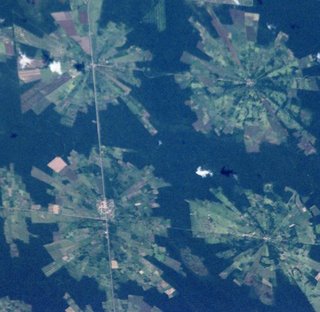 The image to the left of your screen illustrates a pattern that is actually recognized by the United States' National Aeronautics and Space Administration (NASA) as unique to Bolivia.
The image to the left of your screen illustrates a pattern that is actually recognized by the United States' National Aeronautics and Space Administration (NASA) as unique to Bolivia.The image was taken in 2001. A side-by-side comparison of what the place looked like in 1986 and 2001 can be found by clicking here. [1]
What does this photo show? Nothing but the effects of increased migration from the Altiplano to the Santa Cruz lowlands, and the application of Aymara production and land distribution techniques. The pie or radial patterned fields are part of the San Javier resettlement scheme. They are the visual translation of Andean communitarism imported to the Eastern part of the country.
You shouldn't be surprised by the fractioning of the land, this is a common feature of "ancestral" altiplanic methods of production. In post-colonial altiplano, land is/was inherited in such a fractional manner, and of course, with time, efficiency began to suffer. Eventually the mini-fundio became commonplace and nowadays, some communities subsist even under a "surco-fundio" system[2]. The pattern is being replicated in the Bolivian lowlands, despite the availability and knowledge of alternative production methods, we can only expect the same ultimate result for any redistributed lands. The fields illustrated in the photograph are not producing soybean or any other "cash crops" such as rice or wheat, they are too small for efficient production. [3]
What's next? As you read this, the Morales government is preparing the second (or third) Land Reform in Bolivian history, 4.5 million hectares (about 17,375 square miles - the size of the states of the state of Massachusetts and New Jersey combined) are to be redistributed to the indigenous poor, the same folks who are now eking an existence in the communities such as the one seen above, or are just about ready to abandon their minifundios in the altiplano.
Other than property rights being obliterated, what worries me are the upcoming decreases in national food production once the fields targeted for reform are
Alvaro Ruiz has more on the topic.
Notes and Sources:
[1] Detailed explanation is available in the following website: <http://asterweb.jpl.nasa.gov/gallery-detail.asp?name=bolivia>
[2] Surco is refers to each of a field's furrows. Under a "surco-fundio" each row has an owner.
[3] Efficient land use: <http://veimages.gsfc.nasa.gov/1562/tierras_baja_strip.jpg> targeted for land reform.
[4] More on "Fast Track Land Reform" in Zimbabwe: <http://www.hrw.org/reports/2002/zimbabwe/>
Tag: South America, Bolivia, Evo Morales, Land Reform.




3 comments:
Very interesting, what kind of crops are they producing?, dont tell me they migrated there just to subsist.
De todo un poco companero, and yeah, they probably did fine for a while but now many migrants are victims to outdated practices. Farming is a though, though business, even if you have land to begin with you probably have to supplement your income by working in the zafra (sugar cane harvest) or otherwise selling your labor.
It was interesting to come across this blog entry when I was looking for something else. I have been on the ground in this very place. You are wrong about several things. Its in San Julian not San Javier, the people here speak Quechua, not Aymara, the pie shaped pattern of the fields is due to a USAID funded project designed by North Americans, not indigenous culture.
As someone who has studied agricultural economics and ecology, I can assure you that while there are economies of scale in things like soy production, overall small farms are more productive per unit of land, they adapt easier to variations in local topography and have more potential for being environmentally sustainable. The patterns of the fields are because some areas are in fallow and different crops are being grown rather than just one.
Its for this reason that the World Bank supports an orderly agrarian reform process to distribute land to more people rather than have large amounts of land devoted to just one crop.
It seems your perspective on this issue is biased against indigenous campesinos without any knowledge of what the situation is like on the ground.
Post a Comment